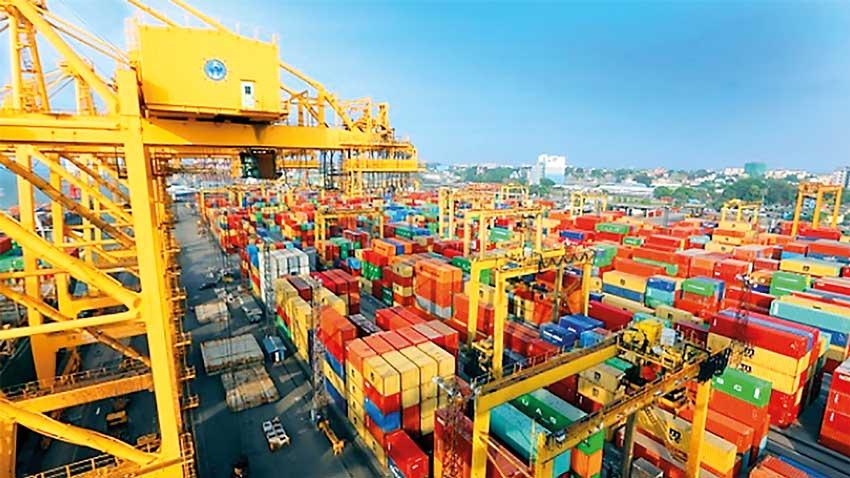13 May 2022 - {{hitsCtrl.values.hits}}

Sri Lanka’s trade deficit narrowed in February this year as import expenditure slightly trended downwards despite high oil prices while export earnings held on maintaining the growth momentum.
According to the trade data released by the Central Bank, the country recorded US$ 781 million deficit in the trade account of the balance of payment in February, down from US$ 858 million deficit recorded in January and the highest ever monthly trade deficit of US$ 1,085 million recorded in December last year. However, it was substantially up from US$ 572 million trade deficit recorded a year ago.
In the month of February, import expenditure on merchandise goods slightly declined to US$1.87 billion from US$ 1.96 billion and US$ 2.24 billion recorded in January this year and December last year.
However, merchandise import expenditure rose by 22.9 percent Year-on-Year (YoY) in the month. The import expenditure is expected to have further declined in March with the floating of rupee on March 7.
Meanwhile, merchandise export earnings increased by 14.7 percent YoY in February to US$ 1.09 billion surpassing the US$ 1 billion mark for the ninth consecutive month despite notable declines in key agri-export categories.
However, terms of trade which is the ratio of the price of exports to the price of imports, deteriorated by 10.7 percent in February from a year ago as the increase in import prices surpassed the increase in export prices.
Meanwhile, the cumulative trade deficit during January to February this year widened to US$ 1.64 billion from US$ 1.23 billion recorded over the same period in 2021. The US$ 262.5 million increase in the fuel bill, US$ 180.4 million increase in textiles and textile articles as well as US$ 21.4 million decline in tea export income were some major contributory factors for the deterioration of the cumulative trade deficit.
Export earnings from industrial goods increased by 19.4 percent YoY to US$ 883.7 million with earnings from textiles and garments almost reaching US$ 500 million recording 12 percent YoY increase.
In addition, earnings from the export of petroleum products increased by 56.8 percent YoY to US$ 150.6 million due to the increase in both prices and volumes of bunker and aviation fuel exports.
However, earnings from agricultural exports in February 2022 declined by 2.1 YoY percent to US$ 202.1 million due to lower export volumes resulting from adverse weather conditions and the shortage of chemical fertiliser. Earnings from tea exports declined by 10.4 percent YoY to US$ 100.9 million while export earnings from spices declined by 18.3 percent YoY to US$27.1 million.
Meanwhile, import expenditure on consumer goods in February rose by 9.5 percent to US$ 298.8 million driven by the increase in expenditure on food and beverages. However, there was a notable decline of 72.2 percent YoY in telecommunication, devices, which include mobile phones in the non-food consumer good sub-category. The expenditure on fuel imports rose by 44.4 percent to US$ 462.2 million in February due to the increase in import prices of crude oil, refined petroleum and coal amidst low import volumes of refined petroleum (including LP Gas) and crude oil.
The average import price per barrel of crude oil increased to US$ 76.41 in February from US$ 64.07 a year ago.
In contrast, import expenditure on other intermediate goods including wheat, food preparations (mainly palm oil), fertiliser and rubber and articles thereof declined primarily driven by low volumes during February when compared to a year ago. In particular, import cost on fertiliser declined by substantial 70.2 percent YoY to US$ 4.2 million in the month.
Expenditure on the importation of investment goods rose by 16.4 percent to US$ 353 million in the month due to a substantial increase in machinery and equipment and building material.
Meanwhile, Workers’ remittances plummeted to US$ 205 million in February from US$ 259 million in the previous month and US$ 580 million a year ago. However, total departures for foreign employment were recorded at 22,074 in the month, contributed mainly by the unskilled (6,548), domestic aid (6,451) and skilled (6,294) categories.
Tourism earnings for the month rose to US$ 174 million from US$ 148 million in the previous month and US$ 9 million a year ago. Notably, the Colombo Stock Exchange (CSE), including the primary and secondary market transactions, recorded a net inflow of US$ 49 million in February for the second straight month of the year. On a cumulative basis, the CSE, including primary and secondary market transactions, recorded a net inflow of US$ 85 million during the two months ending February 2022.
14 Nov 2024 6 minute ago
14 Nov 2024 14 minute ago
14 Nov 2024 2 hours ago
14 Nov 2024 4 hours ago